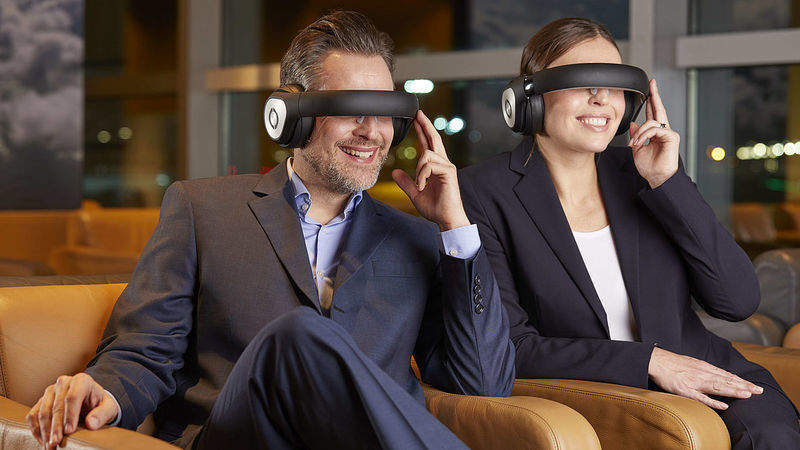
The first movie ever to be watched on a plane was Howdy Chicago on an eleven-passenger hydroplane at the Pageant of Progress exhibition in 1921. However, it took until 1988 before the first in-seat, in-flight entertainment system was tested. Introduced by Northwest Orient Airlines on its Boeing 747s, it was so popular that the airline rolled it out across its entire fleet.
Today, in-flight entertainment is getting ready to take off again with technology that’s set to bring a new lease of life to airport lounges and aircraft.
Inflight VR brings virtual reality to airports and aircraft
Inflight VR, which creates virtual reality-powered (VR) systems for the air industry, has partnered with ground-handling service provider Aviapartner to provide immersive VR content to air travellers at the company’s passenger lounge at Rome’s Fiumicino Airport.
Although a nascent industry, according to Greenlight Insights, VR revenues will reach $7.17bn by the end of the year, rising to $75bn by 2021. While over half of sales are from headsets, VR for enterprise, such as construction and travel, is expected to take more market share.
Inflight VR’s virtual reality experience provides passengers with a headset loaded with immersive entertainment, including shopping, travel experiences, a 3D cinema and games.
The system will soon be available to air passengers as it can integrate into the existing in-flight entertainment infrastructure. Following several flights with Germania and Volotea last year, the headsets are being tested with Iberia until October, with a potential roll out on this airline towards the end of the year.

US Tariffs are shifting - will you react or anticipate?
Don’t let policy changes catch you off guard. Stay proactive with real-time data and expert analysis.
By GlobalDataAvoiding motion sickness is one of the biggest challenges, but Inflight VR’s chief technology officer Dr Elena Kokkinara is a VR motion sickness specialist, having authored several papers on the subject during her PhD in virtual reality.
“The content is something we carefully select,” explains Inflight VR chief commercial officer Raphael Baumann. “Every content offer to clients as part of our catalogue has every scene checked for motion sickness – and is adapted with the content studios if needed – to decide whether it is certifiable for the user case.”
The content is also customisable, meaning airports and airlines can create unique VR experiences for their passengers through the headsets. “They can offer passengers an entirely new service and help their brand establish an innovative image,” says Baumann. “As the vast majority of people still haven’t tried VR you have at least for the next couple of years a great wow factor effect.”
SkyLights trials immersive film content at Dubai International
Another immersive entertainment initiative by Emirates took place earlier this year Dubai International Airport.
With the goal of improving the customer experience, in April and May the airline trialled SkyLights Aero Virtual Reality entertainment technology with customers in selected first class and business class lounges. The SkyLights system is dedicated to providing in-flight entertainment and offers a fixed screen with a wide-angle field of view for 3D and 2D film content, including early-window blockbusters and films from French distributor MK2 Films.
Etihad Airways recently trialled SkyLights for one month in both first and business class lounges at Abu Dhabi International Airport.
“By conducting trials such as this, we already understand that modern travellers expect more information and seek increasingly connected and immersive experiences which engage and entertain them on every level,” says Etihad Airways vice president for guest experience and delivery Linda Celestino.
“The development of this type of technology could also allow us to provide more personalisation and end-to-end entertainment solutions across all customer demographics, reinforcing our strategy of providing greater choice at every stage of the customer journey.”
Lufthansa’s passenger engagement takes off with VR
Last year Lufthansa trialled Avegant’s Glyph video glasses in the business lounge at Frankfurt Airport, offering passengers a cinema experience. Back in 2017, the glasses were awarded the Innovation Award Honoree at the CES technology tradeshow.
The Glyph, as the headset is often referred to, can be used anywhere and for video content or audio, thanks to a separate audio input. “The special feature of the Glyph is the projection directly on the retina, which is more pleasant for the wearer compared to a screen”, says Avegant vice president of business development Eric Trabold.
Lufthansa has focused on VR as a way to engage passengers. Part of another trial last year saw economy class passengers experience premium economy class through an immersive VR experience.
“The spatial impression, such as leg room, gives a much better feeling of what an upgrade means,” explains Lufthansa spokesperson Florian Graenzdoerffer. “As part of the gate promotion, we were able to achieve an increase in upgrades of up to 50%.”
The airline also offers Lufthansa VR, a virtual reality app for mobile devices, which provides an easy introduction to virtual reality and 360-degree videos. “All you need is a pair of cardboard goggles with two lenses in addition to the smartphone,” explains Graenzdoerffer. “Suddenly the viewer stands on the beach of Mauritius, at the Brooklyn Bridge in New York or on the Wan Chai Market in Hong Kong.”
Graenzdoerffer says virtual reality opens up new possibilities of representation. “While a photo or video faithfully reproduces travel destinations, VR applications also arouse additional emotions,” he says.
“Look around in an airplane today. Almost every traveller has a smartphone or tablet in his hands. In a few years, it may be VR glasses – we have to be prepared for this with our content on board.”



